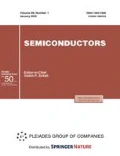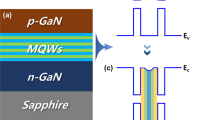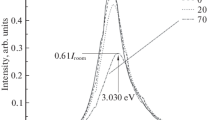Abstract
The capacitance-voltage characteristics and external quantum efficiency of electroluminescence in blue GaN light-emitting diodes (LEDs) with an InGaN quantum well have been investigated in the temperature range 77–300 K. The results obtained are interpreted taking into account the effect of the InGaN/GaN interface states of structural defects and impurities on the capacitance of the GaN LEDs. The nonlinearity of the C −2(U) characteristics observed at low forward bias is attributed to an increase in the interface charge resulting from tunneling of free electrons and their trapping at the interface states. According to estimates, states with a density of about 3 × 1012 cm−2 are present at the interface. A recombination current in the interface region suppresses the injection of charge carriers into the quantum well and decreases the electroluminescence efficiency at high forward bias. Degradation of the optical power of the LEDs, accompanied by an increase in the measured capacitance, is attributed to an increase in the density of charged interface states and changes in their distribution in the band gap.
Similar content being viewed by others
References
R. L. Anderson, Solid-State Electron. 5, 341 (1962).
Y. Zohta, H. Kuroda, R. Nii, and S. Nakamura, J. Cryst. Growth 189–190, 816 (1998).
O. Ambacher, J. Phys. D: Appl. Phys. 31, 2653 (1998).
W. G. Oldham and A. G. Milnes, Solid-State Electron. 7, 153 (1964).
J. P. Donnelly and A. G. Milnes, IEEE Trans. Electron Devices 14, 63 (1967).
J. Oila, K. Saarinen, A. E. Wickenden, et al., Appl. Phys. Lett. 82, 1021 (2003).
K. S. A. Butcher, H. Timmers, Afifuddin, et al., J. Appl. Phys. 92, 3397 (2002).
I. Arslan and N. D. Browning, Phys. Rev. Lett. 91, 165501 (2003).
J. Elsner, R. Jones, M. I. Heggie, et al., Phys. Rev. B 58, 12571 (1998).
T. Takeuchi, C. Wetzel, S. Yamaguchi, et al., Appl. Phys. Lett. 73, 1691 (1998).
Y. T. Rebane, N. I. Bochkareva, V. E. Bougrov, et al., Proc. SPIE 4996, 113 (2003).
N. I. Bochkareva, E. A. Zhirnov, A. A. Efremov, et al., Fiz. Tekh. Poluprovodn. (St. Petersburg) 39, 627 (2005) [Semiconductors 39, 594 (2005)].
J. S. Im, A. Moritz, F. Steuber, et al., Appl. Phys. Lett. 70, 631 (1997).
G. Koley and M. G. Spencer, Appl. Phys. Lett. 78, 2873 (2001).
Author information
Authors and Affiliations
Additional information
__________
Translated from Fizika i Tekhnika Poluprovodnikov, Vol. 39, No. 7, 2005, pp. 829–833.
Original Russian Text Copyright © 2005 by Bochkareva, Zhirnov, Efremov, Rebane, Gorbunov, Klochkov, Lavrinovich, Shreter.
Rights and permissions
About this article
Cite this article
Bochkareva, N.I., Zhirnov, E.A., Efremov, A.A. et al. The effects of interface states on the capacitance and electroluminescence efficiency of InGaN/GaN light-emitting diodes. Semiconductors 39, 795–799 (2005). https://doi.org/10.1134/1.1992637
Received:
Accepted:
Issue Date:
DOI: https://doi.org/10.1134/1.1992637




